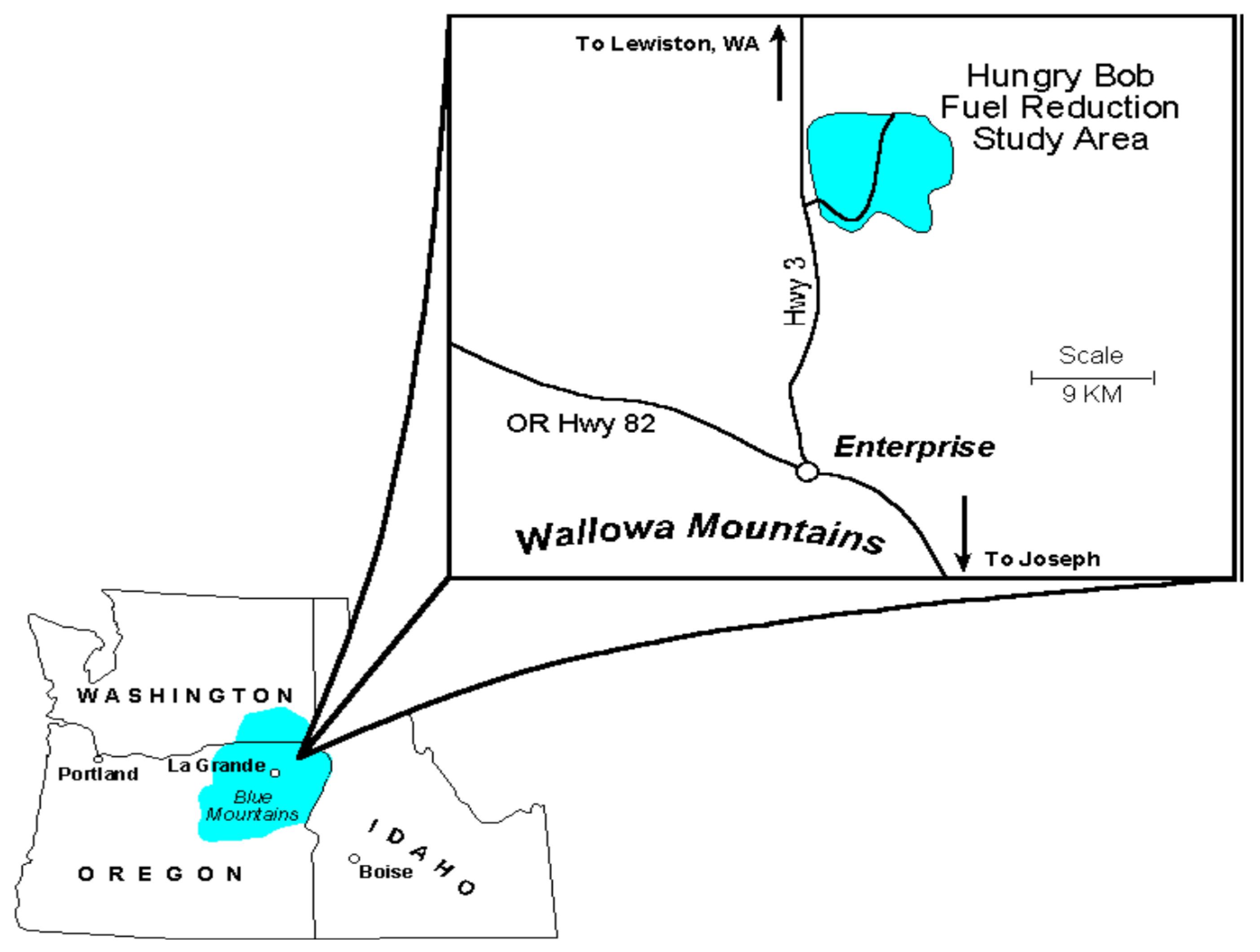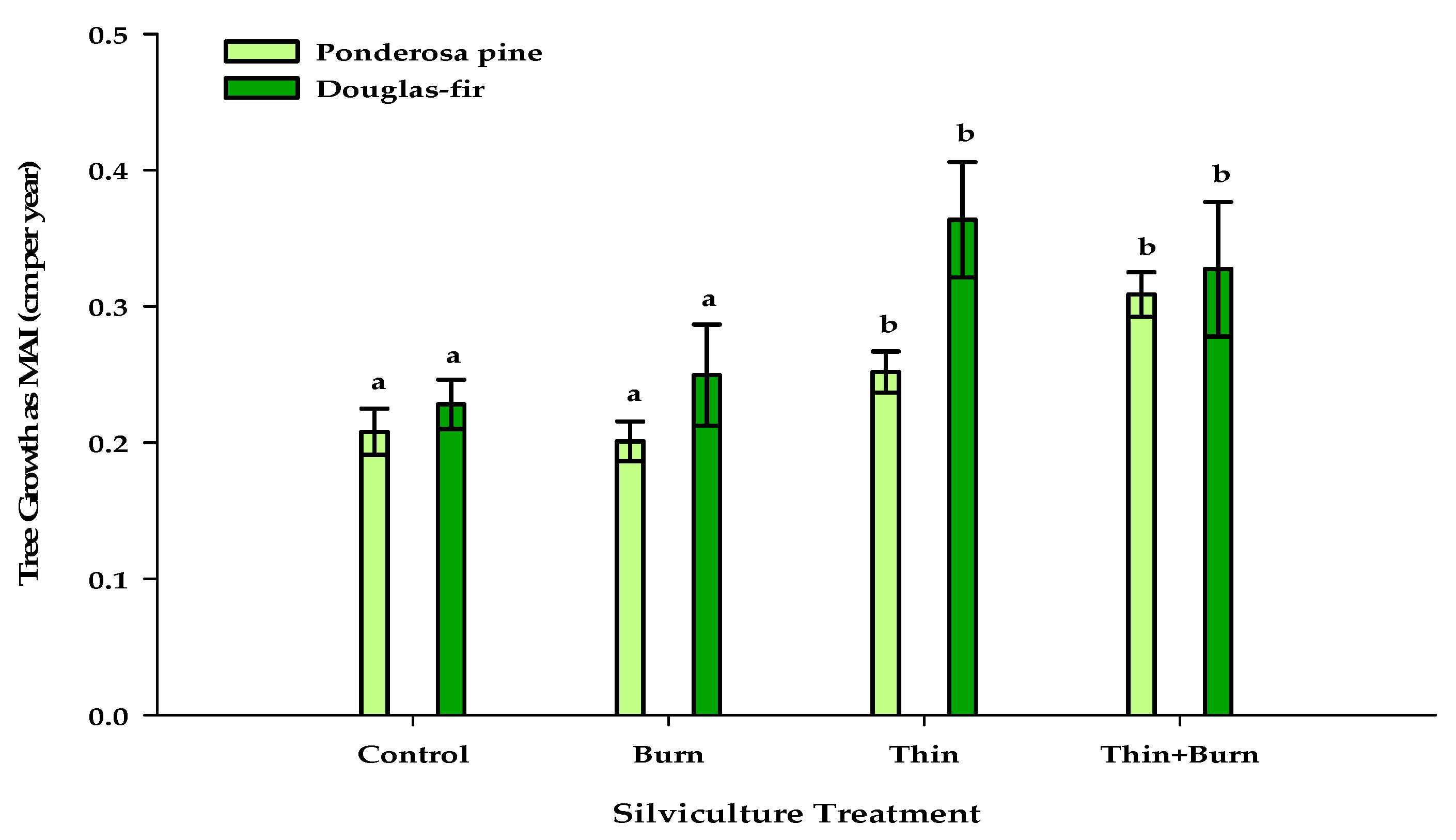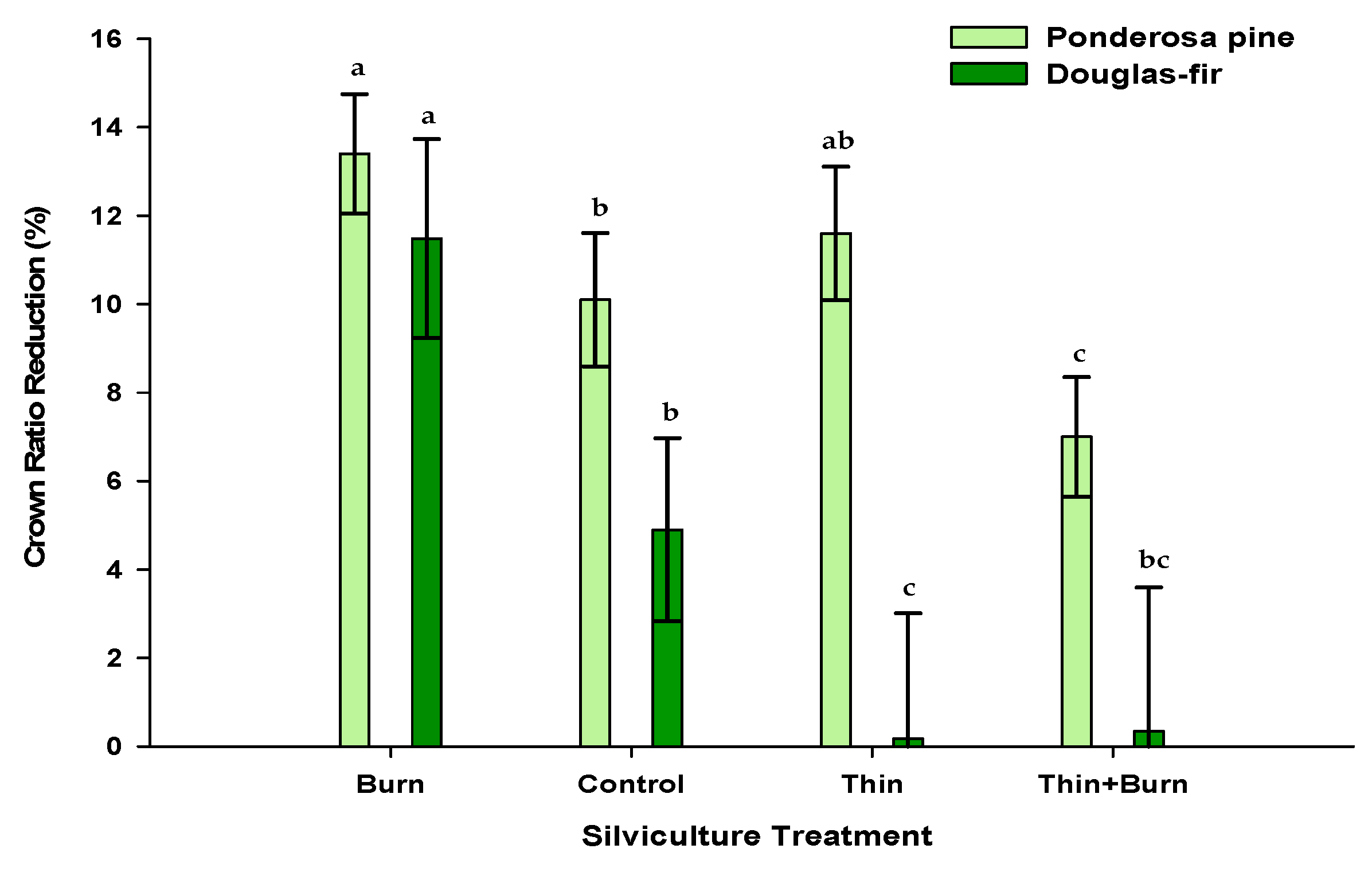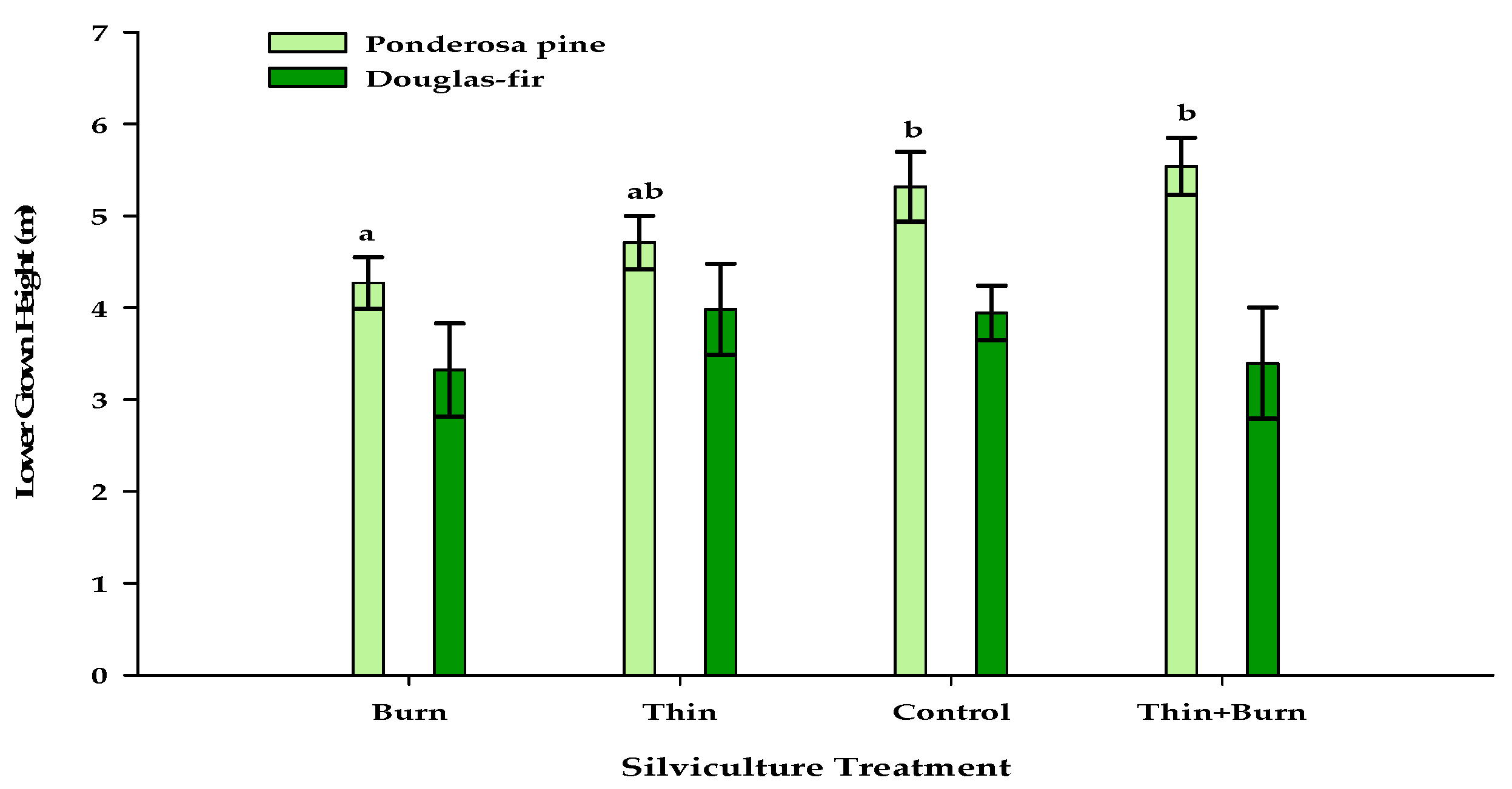The Hungry Bob Fire & Fire Surrogate Study: A 20-Year Evaluation of the Treatment Effects
Abstract
1. Introduction
2. .Materials and Methods
2.1. Site Description
2.2. Field Design
- Untreated control (Control);
- Prescribed fire only, with periodic reburns (Burn);
- Initial and periodic cutting, each time followed by physical removal of large residue; no use of prescribed fire (Thin);
- Initial and periodic cutting, each time followed by prescribed fire (Thin + Burn).
2.3. Stand Structure
2.4. Data Analysis
3. Results
4. Discussion
5. Conclusions
Author Contributions
Funding
Acknowledgments
Conflicts of Interest
References
- Arno, S.F.; Smith, H.Y.; Krebs, M.A. Old Growth Ponderosa Pine and Western Larch stand Structures: Influences of pre-1900 Fires and Fire Exclusion; USDA For. Serv. Intermtn. Res. Sta. Res. Pap, INT-RP-495; United States Department of Agriculture: Washington, WA, USA, 1997; p. 2.
- Harrod, R.J.; McRae, B.H.; Hartl, W.E. Historical stand reconstruction in ponderosa pine forests to guide silvicultural prescriptions. For. Ecol. Manag. 1998. [Google Scholar] [CrossRef]
- Skinner, C.N.; Chang, C. Fire regimes, past and present. In Sierra Nevada Ecosystem Project: Final Report to Congress; Vol. II Assessments and Scientific Basis for Management Options; Wildland Resources Center Report No. 37; Centers for Water and Wildland Resources, University of California: Davis, CA, USA, 1996; pp. 1041–1069. [Google Scholar]
- Keane, R.E.; Agee, J.K.; Fulé, P.; Keeley, J.E.; Key, C.; Kitchen, S.G.; Miller, R.; Schulte, L.A. Ecological effects of large fires on US landscapes: Benefit or catastrophe? Int. J. Wildland Fire 2008, 17, 696–712. [Google Scholar] [CrossRef]
- Agee, J.K. Fire and Other Disturbances of Terrestrial Ecosystems in the Eastern Cascades; USDA Forest Service General Technical Report PNW-GTR-344; United States Department of Agriculture: Washington, WA, USA, 1994.
- Taylor, A.H.; Skinner, C.N. Fire history and landscape dynamics in a late-successional reserve, Klamath Mountains, California, USA. For. Ecol. Manag. 1998, 111, 285–301. [Google Scholar] [CrossRef]
- Touchan, R.; Allen, C.D.; Swetnam, T.W. Fire history and climatic patterns in ponderosa pine and mixed-conifer forests of the Jemez Mountains, Northern New Mexico. In Fire Effects in Southwestern Forests: Proceedings of the Second La Mesa Fire Symposium, 1994 March 29–31; Los Alamos, New Mexico; Allen, C.D., Ed.; General Technical Report RM-GTR-286; U.S. Department of Agriculture, Forest Service, Rocky Mountain Forest and Range Experiment Station: Fort Collins, CO, USA, 1996; pp. 33–46. [Google Scholar]
- Graham, R.T.; Jain, T.B. Ponderosa pine ecosystems. In Proceedings of the Symposium on Ponderosa Pine: Issues, Trends, and Management, 2004 October 18–21, Klamath Falls, OR.; Ritchie, M.W., Maguire, D.A., Youngblood, A., Eds.; Gen. Tech. Rep PSW-GTR-198; Pacific Southwest Research Station, Forest Service, U.S. Department of Agriculture: Albany, CA, USA, 2005; pp. 1–32. [Google Scholar]
- Rehfeldt, G.E. Microevolution of forest trees. In Interior Cedar-hemlock-white Pine Forests, Proceedings of the Symposium on Interior Cedar-Hemlock-White Pine Forests: Ecology and Management, Spokane, WA, USA, 2–4 March 1993; Baumgartner, D.M., Lotan, J.E., Tonn, J.R., Eds.; Department of Natural Resources, Washington State University: Spokane, WA, USA; Pullman, WA, USA, 1994; pp. 92–100. [Google Scholar]
- DeRose, R.J.; Long, J.N. Resistance and Resilience: A Conceptual Framework for Silviculture. For. Sci. 2014, 60, 1205–1212. [Google Scholar] [CrossRef]
- Society for Ecological Restoration International (SER) Science & Policy Working Group. The SER International Primer on Ecological Restoration. 2004. Available online: www.ser.org (accessed on 15 September 2018).
- Addington, R.N.; Aplet, G.H.; Battaglia, M.A.; Briggs, J.S.; Brown, P.M.; Cheng, A.S.; Dickinson, Y.; Feinstein, J.A.; Pelz, K.A.; Regan, C.M.; et al. Principles and Practices for the Restoration of Ponderosa Pine and Dry Mixed-Conifer Forests of the Colorado Front Range; RMRS-GTR-373; U.S. Department of Agriculture, Forest Service, Rocky Mountain Research Station: Fort Collins, CO, USA, 2018; 121p.
- Millar, C.I. Sierra Nevada Ecosystem Project. Sierra Nevada Ecosystem Project, Final Report to Congress; Vol. I Assessment Summaries and Management Strategies, Centers for water and Wildland Resources, Report No. 36; Cooperative report of the PSW Research Station, PSW Region, USDA, for the Sierra Nevada Framework Project, Sacramento, CA; University of California: Davis, CA, USA, 1996; 209p. [Google Scholar]
- Weatherspoon, C.P.; Skinner, C.N. Landscape-level strategies for forest fuel management. In Sierra Nevada Ecosystem Project: Final report to Congress; Vol. II Assessments and Scientific Basis for Management Options; Wildland Resources Center Report No. 37; Centers for Water and Wildland Resources, University of California: Davis, CA, USA, 1996; pp. 1471–1492. [Google Scholar]
- Agee, J.K.; Lolley, M.R. Thinning and prescribed fire effects on fuels and potential fire behavior in an eastern Cascades forest, Washington, USA. Fire Ecol. 2006, 2, 3–19. [Google Scholar] [CrossRef]
- Mutch, R.W.; Cook, W.A. Restoring fire to ecosystems: Methods vary with land management goals. In The Use of Fire in Forest Restoration; Hardy, C.C., Arno, S.F., Eds.; General Technical Report INT-GTR-341; USDA Forest Service, Intermountain Research Station: Ogden, UT, USA, 1996; pp. 9–11. [Google Scholar]
- Edminster, C.B.; Weatherspoon, C.P.; Neary, D.G. The Fire and Fire Surrogates Study: Providing guidelines for fire in future forest watershed management decisions. In Land Stewardship in the 21st Century: The Contributions of Watershed Management; 2000 March 13-16; Tucson, AZ.; Ffolliott, P.F., Baker, M.B., Jr., Edminster, C.B., Dillon, M.C., Mora, K.L., Eds.; Proc. RMRS-P-13; U.S. Department of Agriculture, Forest Service, Rocky Mountain Research Station: Fort Collins, CO, USA, 2000; pp. 312–315. [Google Scholar]
- Youngblood, A.; Metlen, K.L.; Knapp, E.E.; Outcalt, K.W.; Stephens, S.L.; Waldrop, T.A.; Yaussy, D. Implementation of the fire and fire surrogate study—A national research effort to evaluate the consequences of fuel reduction treatments. In Balancing Ecosystem Values: Innovative Experiments for Sustainable Forestry: Proceedings of a Conference; Peterson, C.E., Maguire, D.A., Eds.; Gen. Tech. Rep. PNW-635; U.S. Department of Agriculture, Forest Service, Pacific Northwest Research Station: Portland, OR, USA, 2005; pp. 315–321. [Google Scholar]
- Youngblood, A.; Wright, C.S.; Ottmar, R.D.; McIver, J.D. Changes in fuelbed characteristics and resulting fire potentials after fuel reduction treatments in dry forest of the Blue Mountains, northeastern Oregon. For. Ecol. Manag. 2008, 255, 3151–3169. [Google Scholar] [CrossRef]
- McIver, J.D.; Youngblood, A.; Niwa, C.; Ottmar, R.; Smith, J.; Tiedemann, A. Hypotheses on the ecological effects of alternative fuel reduction methods. In Proceedings of the Society of American Foresters, Annual Convention, Portland, OR, USA, 11–15 September 1999; Society of American Foresters: Bethesda, MA, USA, 2000; pp. 552–555. [Google Scholar]
- Youngblood, A.; Grace, J.; McIver, J.D. Delayed conifer mortality after fuel reduction treatments: Interactive effects of fuel, fire intensity, and bark beetles. Ecol. Appl. 2009, 19, 321–337. [Google Scholar] [CrossRef] [PubMed]
- Thorson, T.D.; Bryce, S.A.; Lammers, D.A.; Woods, A.J.; Omernik, J.M.; Kagan, J.; Pater, D.E.; Comstock, J.A. Ecoregions of Oregon (Color Poster with Map, Descriptive Text, Summary Tables, and Photographs); Map Scale 1:1,500,000; U.S. Geological Survey: Reston, VA, USA, 2003. Available online: http://people.oregonstate.edu/~muirp/FuelsReductionSWOregon/ToolsResources/EcoregionsOregonLevelIVEPA.pdf (accessed on 14 September 2018).
- McIver, J.; Erickson, K.; Youngblood, A. Principal Short-Term Findings of the National Fire and Fire Surrogate Study; General Technical Report PNW-GTR-860; USDA Forest Service, Pacific Northwest Research Station: Portland, OR, USA, 2012; 210p.
- Youngblood, A.; Metlen, K.L.; Coe, K. Changes in stand structure and composition after restoration treatments in low elevation dry forests of northeastern Oregon. For. Ecol. Manag. 2006, 234, 143–163. [Google Scholar] [CrossRef]
- Chen, W.W.; Deo, R.S. Weighted least squares approximate restricted likelihood estimation for vector autoregressive processes. Biometrika 2010, 97, 231–237. [Google Scholar] [CrossRef]
- Studnicki, M.; Madry, W.; Derejko, A.; Noras, K.; Wojcik-Gront, E. Four-way data analysis within the linear mixed model modelling framework. Sci. Agric. 2015, 72, 411–419. [Google Scholar] [CrossRef]
- SAS Institute Inc. SAS/STAT® 9.4 TM User’s Guide; SAS Institute Inc.: Cary, NC, USA, 2014. [Google Scholar]
- Ott, R.L.; Longnecker, M. An Introduction to Statistical Methods and Data Analysis, 5th ed.; Cengage learning: Voston, MA, USA, 2001; pp. 1053–1057. ISBN 0-471-38182-9. [Google Scholar]
- Stevens, J.T.; Safford, H.D.; Latimer, A.M. Wildfire-contingent effects of fuel treatments can promote ecological resilience in seasonally dry conifer forests. Can. J. For. Res. 2014, 44, 843–854. [Google Scholar] [CrossRef]
- Strahan, R.T.; Stoddard, M.T.; Springer, J.D.; Huffman, D.W. Increasing weight of evidence that thinning and burning treatments help restore understory plant communities in ponderosa pine forests. For. Ecol. Manag. 2015, 353, 208–220. [Google Scholar] [CrossRef]
- McIver, J.D.; Stephens, S.L.; Agee, J.K.; Barbour, J.; Boerner, R.E.; Edminster, C.B.; Erickson, K.L.; Kerry, A.; Farris, G.; Fettig, C.J.; et al. Ecological effects of alternative fuel-reduction treatments: Highlights of the National Fire and Fire Surrogate study (FFS). Int. J. Wildland Fire 2013, 22, 63–82. [Google Scholar] [CrossRef]
- Zhang, J.; Oliver, W.W.; Busse, M.D. Growth and development of ponderosa pine on sites of contrasting productivities: Relative importance of stand density and shrub competition effects. Can. J. For. Res. 2006, 36, 2426–2438. [Google Scholar] [CrossRef]
- Thies, W.G.; Westlind, D.J.; Loewen, M.; Brenner, G. A Field Guide to Predict Delayed Mortality of Fire-Damaged Ponderosa Pine: Application and Validation of the Malheur Model; Gen. Tech. Rep. PNW-GTR-769; U.S. Department of Agriculture, Forest Service, Pacific Northwest Research Station: Portland, OR, USA, 2008; 16p.
- Agee, J.K.; Skinner, C.N. Basic principles of forest fuel reduction treatments. For. Ecol. Manag. 2005, 211, 83–96. [Google Scholar] [CrossRef]
- Flathers, K.N.; Kolb, T.E.; Bradford, J.B.; Waring, K.M.; Moser, W.K. Long-Term Thinning Alters Ponderosa Pine Reproduction in Northern Arizona. For. Ecol. Manag. 2016, 374, 154–165. [Google Scholar] [CrossRef]
- Long, J.N.; Windmuller-Campione, M.; DeRose, R.J. Building Resistance and Resilience: Regeneration Should Not be Left to Chance. Forests 2018, 9, 270. [Google Scholar] [CrossRef]
- Kerr, G.; Haufe, J. Thinning Practice: A Silvicultural Guide; Version 1.0. United Kingdom Forestry Commission, Publications; Silvan House Publications: Edinburgh, UK, 2011; 54p. [Google Scholar]
- USDA Forest Service. Increasing the Pace of Restoration and Job Creation on Our National Forests; United States Department of Agriculture, Forest Service: Washington, DC, USA, 1 February 2012; 9p. Available online: https://www.fs.fed.us/sites/default/files/legacy_files/media/types/publication/field_pdf/increasing-pace-restoration-job-creation-2012.pdf (accessed on 14 September 2018).





| Treatment | N | ∆ DBH (cm) | MAI (cm) | Crown Ratio Reduction (%) | Lower Crown Height (m) | |
|---|---|---|---|---|---|---|
| Thin + Burn | 306 | ± CI | 4.0366 0.2018 | 0.3105 0.0155 | 6.3725 1.3522 | 5.35 0.29 |
| Thin | 461 | ± CI | 3.5427 0.1955 | 0.2725 0.0150 | 9.4902 1.4358 | 4.57 0.25 |
| Control | 534 | ± CI | 2.8182 0.1627 | 0.2168 0.0125 | 8.0431 1.2414 | 4.79 0.25 |
| Burn | 409 | ± CI | 2.6809 0.1764 | 0.2062 0.0136 | 13.1907 1.2851 | 4.17 0.25 |
| Treatment | Stand DBH (cm) | df | p | MAI (cm per year) | df | p |
|---|---|---|---|---|---|---|
| Burn vs C | 2.76 (1.6) | 408 | 0.0010 | 0.0001 (0.0197) | 408 | ns |
| Thin vs C | 0.94 (1.7) | 460 | ns | 0.0621 (0.0199 | 460 | <0.0001 |
| Thin + Burn vs C | 4.09 (1.9) | 305 | <0.0001 | 0.1021 (0.0213) | 305 | <0.0001 |
| Thin+ Burn vs Burn | 1.77 (1.6) | 305 | 0.0290 | 0.1159 (0.0221) | 305 | <0.0001 |
| Treatment | Crown Ratio (%) | df | p | Crown Ratio Reduction (∆ %) | df | p |
|---|---|---|---|---|---|---|
| Burn vs C | −5.84 (1.8) | 408 | <0.0001 | 5.23 (1.8) | 408 | <0.0001 |
| Thin vs C | 1.59 (1.8) | 460 | ns | 1.41 (2.0) | 460 | ns |
| Thin + Burn vs C | 1.23 (2.2) | 305 | ns | -3.81 (2.1) | 305 | 0.0003 |
| Thin + Burn vs Burn | 7.24 (2.0) | 408 | <0.0001 | -7.27 (1.9) | 408 | <0.0001 |
© 2018 by the author. Licensee MDPI, Basel, Switzerland. This article is an open access article distributed under the terms and conditions of the Creative Commons Attribution (CC BY) license (http://creativecommons.org/licenses/by/4.0/).
Share and Cite
McCaskill, G.L. The Hungry Bob Fire & Fire Surrogate Study: A 20-Year Evaluation of the Treatment Effects. Forests 2019, 10, 15. https://doi.org/10.3390/f10010015
McCaskill GL. The Hungry Bob Fire & Fire Surrogate Study: A 20-Year Evaluation of the Treatment Effects. Forests. 2019; 10(1):15. https://doi.org/10.3390/f10010015
Chicago/Turabian StyleMcCaskill, George L. 2019. "The Hungry Bob Fire & Fire Surrogate Study: A 20-Year Evaluation of the Treatment Effects" Forests 10, no. 1: 15. https://doi.org/10.3390/f10010015
APA StyleMcCaskill, G. L. (2019). The Hungry Bob Fire & Fire Surrogate Study: A 20-Year Evaluation of the Treatment Effects. Forests, 10(1), 15. https://doi.org/10.3390/f10010015




